
|
||||||||||||
|
|
|
Rhinos
Rhinos have existed for over 50 million years. In the past, at one time there were 30 species of rhinos, including the largest land mammal that ever lived. Rhinos were also common in North America. Rhinos belong to the same group of animals as horses; both are "odd-toed ungulates", or Perissodactyla.
Rhinos have three toes, which leave distinctive tracks. They have thick skin which forms inflexible plates over the shoulders, haunches, sides, forehead and cheeks. Rhinos are surprisingly agile, despite their bulky appearance. They have poor eyesight, but exceptional hearing and an acute sense of smell.
Today, only five species of rhino survive. These five species are further divided into 11 identified subspecies. All rhinos are under threat of, and all but one species is on the verge of, extinction. Without drastic action, some rhinos could be extinct in the wild within the next 10-20 years. Only about 25,000 of these marvelous creatures survive in the wild with another 1,250 in captivity. Of these rhinos, more than two thirds are white rhinos. There are only around 7,300 of the other four species combined. Best current population estimates are:
The Northern White Rhino of
central Africa is now "possibly extinct" in the wild and the Javan Rhino
"probably extinct" in Vietnam, after poachers killed the last animal there
in 2010. The black rhino has suffered the most spectacular rate of decline of all rhino species in the last 10 to 15 years with populations reduced 85%. The rhino is being exterminated by poachers who sell the horn for medicinal or ornamental purposes in Asia and the Middle East. In Yemen rhino horn is carved into traditional dagger handles, which is worn by men as a sign of wealth. Without drastic action, four species of rhino could be extinct in the wild within the next 10 years.
Of these rhinos, over half are of a single species - the white rhino. Poachers in Africa have been known to tap power lines and electrocute rhinos just so they can saw off the animals' horns. That's just one more instance of the immeasurable cruelty humans are capable of showing animals "War in Africa often puts a lot of hungry troops in areas where there isn't much food, in which case if they eat wild flesh they are going to really devastate the area," Jane Goodall, a leading naturalist and author renowned for her studies on wild chimpanzees. Africa's wars have displaced millions of people, creating waves of malnourished refugees who often have little choice but to kill wild animals for food. Valuable habitat has been destroyed by battles while in some countries elephants and rhinos have been ruthlessly hunted for their ivory and horns to fund both government and rebel war efforts Javan Rhino (Rhinoceros sondaicus) Critically Endangered
No more than 44 individuals – believed to be stable Rarest of all rhinos, the Javan rhino survives only in Indonesia’s Ujung Kulon National Park. Sadly, this year, we believe that the last Javan rhino was poached in Vietnam’s Cat Loc Reserve. In Ujung Kulon, best survey estimates, backed up with camera-trap data, suggest that no more than 44 animals remain in the park. Of these, we suspect that there are only four or five females with breeding potential. The highest priority actions for Javan rhinos are continued protection of the existing population and collaborative efforts to expand useable habitat in Ujung Kulon as a precursor to establishing a second, ‘insurance’ population elsewhere in Indonesia. Sumatran Rhino (Dicerorhinus sumatrensis) Critically Endangered
Fewer than 200 individuals – decreasing Only about 200 Sumatran rhinos survive in fragmented populations on the islands of Sumatra and Borneo. In Sumatra, Indonesia, between 130 and 175 rhinos are scattered among three populations in Bukit Barisan Selatan, Way Kambas, and Gunung Leuser National Parks. In Sabah, Borneo, Malaysia, approximately 20 Sumatran rhinos remain in fragmented populations; no evidence of rhinos has been seen in peninsular Malaysia for several years. The primary threats facing this species are human encroachment into the rhinos’ habitats and poaching. The future of Sumatran rhinos depends on continued protection by highly trained anti-poaching teams, intensive management within protected areas, and creating incentives for local communities to decrease encroachment. Greater One-horned Rhino (Rhinoceros unicornis)
Vulnerable At least 2,850 individuals – increasing The greater one-horned rhino population now numbers around 2,850 and is slowly growing. In 2010, poaching pressure on the species in India and Nepal slightly decreased. Greater one-horned rhino numbers are increasing mostly because of the growing population in Kaziranga National Park, which now numbers more than 2,000 animals. To continue this growth, however, protection measures must endure and efforts to spread the population out among different protected areas over the next few years must continue. Black Rhino (Diceros bicornis) Critically Endangered At least 4,860 individuals – slowly increasing Black rhino populations were brutally hit by well-organized and highly-armed gangs of poachers in 2010, particularly in South Africa. In Zimbabwe, where we moved animals to safer areas, poaching decreased significantly this year. Black rhino strongholds include South Africa, Namibia, Kenya and Zimbabwe, in descending order. Highest priorities include continuing to protect existing populations from organized criminal poaching gangs and ensuring effective prosecution of wildlife crime.
White Rhino (Ceratotherum simum) Near Threatened At least 20,150 individuals - increasing White rhino populations continue to grow despite the heaviest poaching pressure faced by the species in 16 years. South Africa alone lost 333 rhinos to poaching syndicates this year. More than 40 percent of these were lost in Kruger National Park, which borders Mozambique. Private sector game ranches are also under siege. Despite poaching pressure, the southern white rhino is still increasing and is considered ‘Near Threatened’ by the IUCN.
To Find Out More about Endangered Species Visit The Organizations Below
|
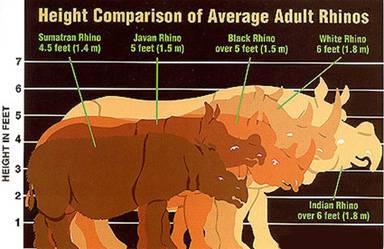
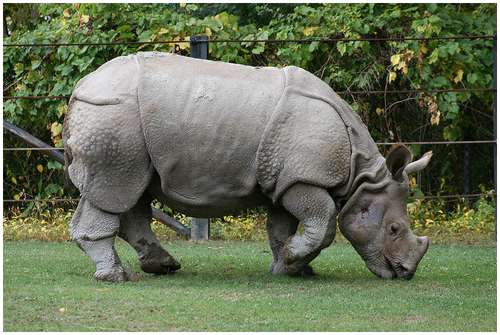
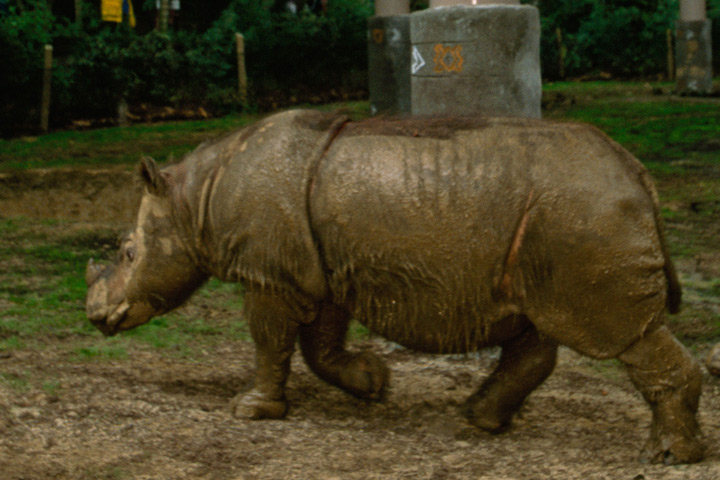
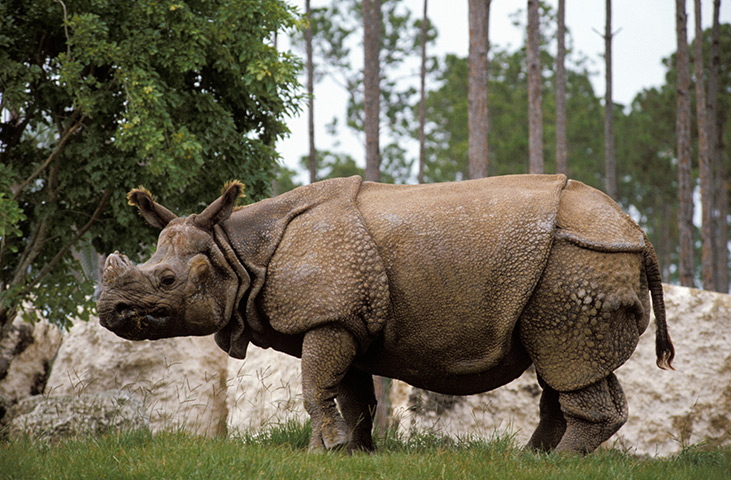
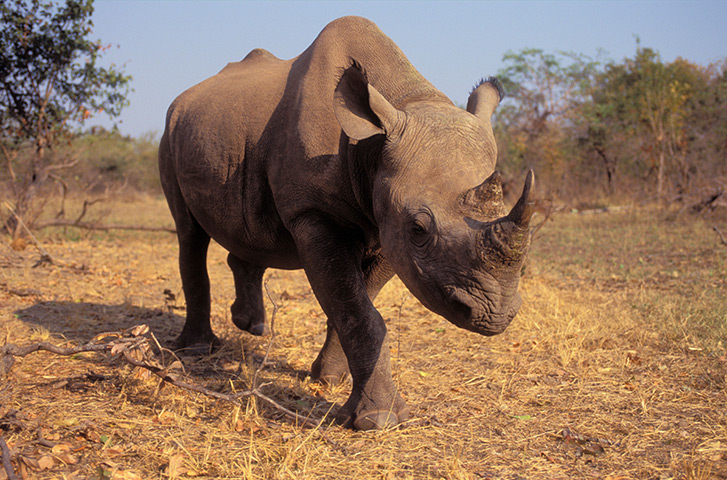
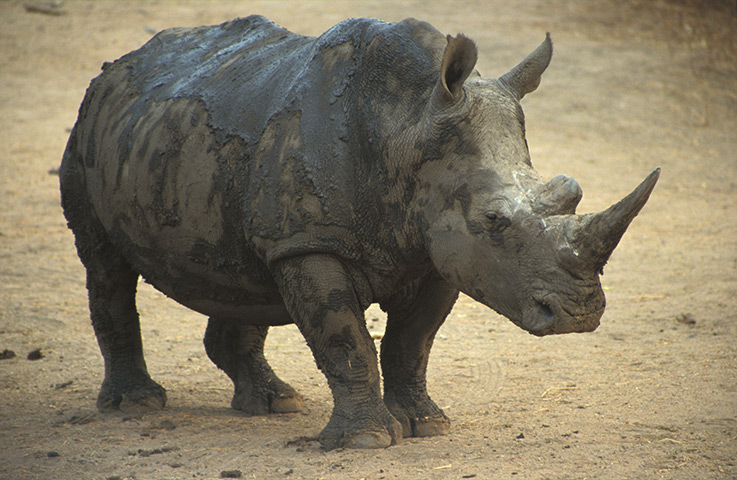
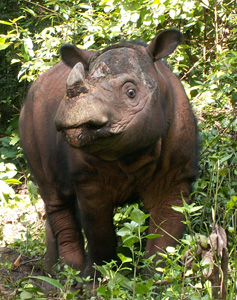 A
group of rhinos is called a “crash”.
A
group of rhinos is called a “crash”.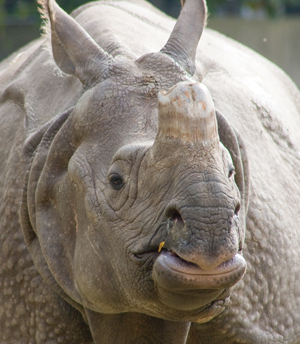 Three
of the five surviving rhino species (black, Javan and Sumatran) are
Critically Endangered, which means there is at least a 50% chance that
these species will become extinct within three generations (for rhinos,
this means about 30-60 years).
Three
of the five surviving rhino species (black, Javan and Sumatran) are
Critically Endangered, which means there is at least a 50% chance that
these species will become extinct within three generations (for rhinos,
this means about 30-60 years).



